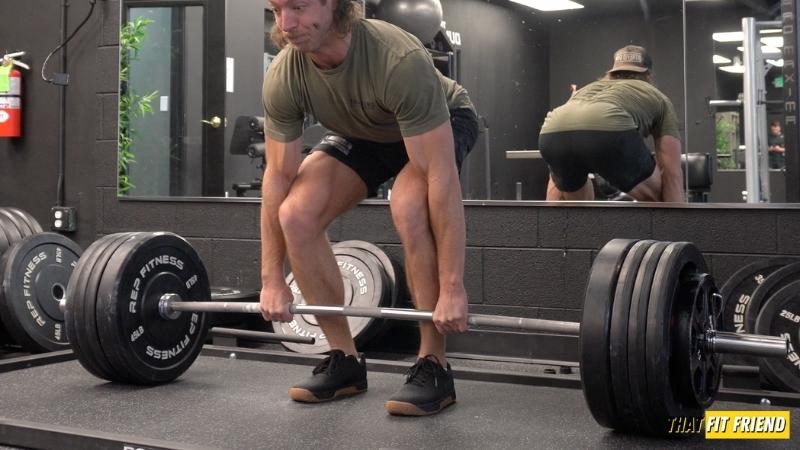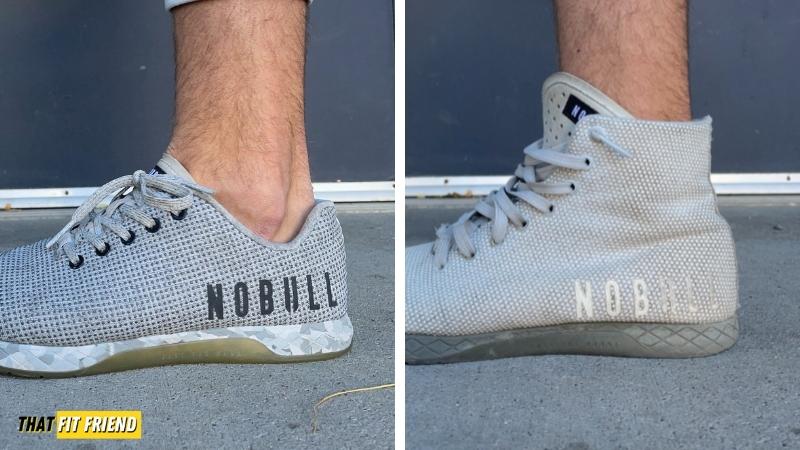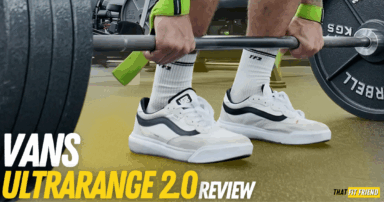That Fit Friend is supported by its readers. I [Jake Boly] run this site myself and buy the gear I review. If you purchase through my site, I may earn commissions on sales, read more here!

The NOBULL Impact is designed for lifting and CrossFit from NOBULL. The Impact has a few key updates and construction changes compared to the original NOBULL Outwork.
Both of these models deliver consistent performances, so that begs the question, “Should you go with the NOBULL Impact or Outwork?”
If we break down the construction of the NOBULL Impact versus the tried and true Outwork, we can better identify which cross-training shoe is best for your training needs.
As a fan of both the NOBULL Impact and NOBULL Outwork for different reasons, I wanted to test both in a range of contexts to see which is superior so you can make a more educated buying decision.
FYI: NOBULL rebranded the NOBULL Trainer to the NOBULL Outwork and the Trainer+ to I mpact. I updated the text in this article, but I may have missed one or two name changes!
NOBULL Outwork Vs NOBULL Impact At a Glance
I get asked a lot about my thoughts on the NOBULL Outwork versus the NOBULL Impact. There are a lot of similarities between these shoes. By that same token, though, their few differences make a big difference.
Both shoes will work exceptionally well for lifting and CrossFit. However, if you want a shoe better suited for cross-training, short runs, and even walking then you’ll want to explore the NOBULL Impact.
That said, the stack height in the Impact is higher so it may not be as optimized for things like 1-RM deadlifts, but I don’t think that will be a major concern for most recreational lifters who need a shoe for general strength work.
- Heel-to-Toe Drops: 4mm
- Removable Insoles: Yes
- Widths: Regular
- Best for CrossFit: Impact
- Best for Lifting: Outwork
- Best for Running: Impact
- Best for Casual Wear: Outwork

NOBULL Outwork

NOBULL Trainer+
On the market for new cross-training shoes? Check out my TF2 Cross-Training Shoe Finder. This calculator matches you with trainers that I’ve reviewed that match your training needs and wants best.
NOBULL Impact Vs NOBULL Outwork Performance
To break down the performance of the NOBULL Impact versus the Outwork, I’m going to talk about how these shoes perform in different contexts. This way you can better contextualize how these models would work for your training needs and wants.
NOBULL Impact Vs NOBULL Outwork for Lifting and CrossFit
For general lifting, the NOBULL Impact and Outwork both perform well. Each shoe’s midsole delivers enough stability to support heavy training sets and I’ve deadlifted well over 455 lbs and squatted over 355 lbs in both models without stability issues.
The Impact does have a slight have a bit more toe spring which could be something to consider for certain exercises. For example, the mixture of the Impact’s toe spring and higher stack height make it a less desirable cross-training shoe for deadlifts.
In the context of CrossFit, I like both of these models. Due to its reworked and thicker midsole, I think the NOBULL Impact will be more comfortable for most lifters and athletes during box jumps and shorter runs.
For rope climbs and abrasion resistance, both of these shoes excel, and I don’t think you can go wrong with either when it comes to their durability and tackling CrossFit workouts.
I think if you prefer having a lower-to-the-ground and more stable feel when lifting and doing CrossFit, then the NOBULL Outwork will be the call. However, if you like a bit more comfort and “bounce” in your shoes, then the Trainer+ is a good option.
Winner: It depends. For more stability, go NOBULL Outwork. For more comfort, go NOBULL Impact.
NOBULL Impact Vs Outwork for HIIT, Plyometrics, and Versatile Training
Both of these shoes work for HIIT training, plyometrics, and more versatile training, but I do think there’s a winner here. When it comes to the pros of both of these models’ training in this context, I like the outsole and upper constructions in both shoes.
The outsoles in both models grip really well on a variety of surfaces, and the upper constructions are highly durable, which is another perk for outdoor training and versatile workouts.
The main difference, though, is the support and responsiveness that come with each model, and this is where I think the NOBULL Impact takes the edge. The shoe’s medium-density EVA midsole provides a bit more “pop” when jumping and is more forgiving for exercises like double-unders.
If you’re wanting a shoe purely for versatile training and you’re not worried about how the shoe’s stack height influences specific lifting asks, then the NOBULL Impact is a really good option to explore.
Winner: NOBULL Impact
NOBULL Impact Vs Outwork for Walking, Running, and Daily Wear
In the context of walking, running, and daily wear, both shoes will have slightly different performances for each setting. For daily wear, I like both models and feel that they’re good, durable options for wearing out and about.
The full rubber outsoles protect the midsole construction in each model well and the upper construction is easy to clean which is another perk, especially if you’re wearing these for commuting and travel.
Regarding walking and running, I do prefer the NOBULL Impact a bit more and this is due to the midsole construction and herringbone lug patterned outsole. I think this shoe is a bit more forgiving for running and walking and the outsole feels durable for tackling walks and runs on different surfaces.
Don’t get me wrong, you can use the NOBULL Outwork for short runs and walking, but I do think you’ll notice that its stability causes its overall comfort to dip a little bit.
Winner: NOBULL Impact, but for daily wear, both models are good options.
NOBULL Trainer+ Vs NOBULL Trainer Construction
I’m going to discuss individual construction areas on each shoe to discuss the construction of the NOBULL Impact and Outwork. This will hopefully make this section easier to read.
Outsole
One of the main construction differences between the NOBULL Impact and NOBULL Outwork is their outsole construction. Both models feature full rubber outsoles that help protect the midsole when training on different surfaces.
The NOBULL Impact has a slightly thicker rubber outsole that is built with a herringbone lug pattern. The outsole of this wraps over the entirety of the toe box which I like for durability purposes.
The NOBULL Outwork features a full rubber outsole that has a traditional lug patterning. This outsole also wraps over the toe and does a good job with traction and durability.
Midsole
The midsole construction of the Trainer+ and Trainer is also one of the big differences between these models. The reworked midsole in the Outwork is designed to provide a more comfortable ride in this shoe.
In the NOBULL Impact, there’s a thicker medium-density EVA foam that runs throughout the entirety of the shoe. This midsole provides a slightly more responsive and comfortable feel compared to the NOBULL Outwork.
In the NOBULL Outwork, we have a fairly thin high-density foam midsole that provides a high level of stability when training. The NOBULL Outwork’s midsole has a slight edge for stability and gives you a closer to the ground feel when training.
The different midsole constructions also change the stack height in these shoes. The NOBULL Impact has a significantly higher stack height compared to the NOBULL Outwork, and this is why I’m not the biggest fan of deadlifts in this model.
Upper
The upper construction in both models is consistent. The NOBULL Impact and Outwork have SuperFabric uppers that cover the entirety of the shoe with similar reflective NOBULL branding on the lateral heel.
While I like the SuperFabric upper in both shoes for durability purposes, I do think both models can run relatively hot at times. I noticed this model in the NOBULL Trainer+ and I think that has to do with their slightly heavier construction.
Laces and Tongue
The tongue construction in both of these shoes is consistent. Each model comes with a lightweight perforated tongue which does somewhat help with the shoe’s ability to breathe well.
The lacing system itself is slightly different in both shoes. The NOBULL Trainer+ features an internal web-lacing system with six eyelets that provides the midfoot in this shoe with a nice level of security.
The NOBULL Outwork has a traditional lacing system with five eyelets and metal eyelet rings. Despite being built differently, this model’s lacing system provides a nice level of security.
Insole
Both of these shoes have removable insoles which is a nice feature for anyone that wants to put their own inserts and orthotics into these models. The upper volume in the Impact is slightly higher so it may be a better bet for anyone with custom inserts.
You can use custom inserts in the NOBULL Outwork as well, but I’d suggest using thinner insoles in them if you plan to use your own. This will help prevent them from feeling too tight.
Weight and Heel-to-Toe Drop
The heel-to-toe drop in the NOBULL Impact and NOBULL Outwork remains the same consistent drop that NOBULL has always used. The NOBULL Impact and Outwork both have a 4mm heel-to-toe drop.
Concerning weight, there is a difference between these models. The NOBULL Impact is slightly heavier than the Outwork and this is due to their thicker midsole and outsole materials.
- NOBULL Impact Weight: 12.75 oz (for my size 10 model)
- NOBULL Outwork Weight: 10.7 oz (for my size 10 model)
NOBULL Impact Vs Outwork Sizing
The sizing and fit are fairly consistent with both the NOBULL Impact and Outwork. I think most lifters and athletes should be safe going true-to-size in both of these trainers.
However, there are a few specific sizing and fit scenarios where each of these models can vary. For example, in the NOBULL Trainer, you may want to size up a half size if you have a wide foot. This should award you with a little more room in the toe box.
Additionally, if you have custom inserts or insoles, then you may want to consider the NOBULL Impact. This shoe has a bit more volume through the midfoot and toe box which can accommodate the use of inserts better than the NOBULL Outwork.
- NOBULL Outwork Sizing Thoughts: Go true-to-size. Size up a .5 size if you have a wide foot.
- NOBULL Impact Sizing Thoughts: Go true-to-size.
In the context of if you already wear NOBULL Outwork, then I’d say play it safe and opt for the size that already works for you. For example, if you wear a half size up in the regular Outwork, then you should go for the same size in the Trainer+.
If you have additional sizing and fit questions on the NOBULL Outwork and NOBULL Impact, hit me in the comments below.
NOBULL Trainer+ Vs NOBULL Trainer Durability
Durability is an area where both the NOBULL Impact and Outwork excel. Both of these shoes deliver durable construction to match the demands of most cross-training, CrossFit, and lifting settings.
Between these two models, I don’t think you’ll run into any glaring durability issues right away during your training sessions. Both models feature NOBULL’s signature SuperFabric on their uppers and they do well with abrasion resistance.
The medium-density EVA foam on the NOBULL Impact also prevents breakdown and is fairly easy to clean. This is similar to the high-density foam midsole used in the traditional NOBULL Outwork, too.
I also like that both models feature full rubber outsoles for anyone wanting to train outside in their NOBULL training shoes. These outsoles help protect the midsole and any form of scuffing or midsole breakdown that concrete and asphalt can cause.
The only area where the durability of each of these shoes could differ is that the Impact does have a slight edge for daily wear and outdoor training. I like this model’s thick outsole and herringbone lug patterning, which really increases this shoe’s durability in a variety of settings.
NOBULL Impact Vs Outwork Vs High-Top Outwork
If you’re debating between the NOBULL Impact, NOBULL Outwork, and NOBULL Outwork High-Top, I wanted to discuss a few similarities and differences across all of these models.
Regarding similarities, the upper construction is consistent throughout, and every model features NOBULL’s SuperFabric upper material. Additionally, the midsole and outsole construction of the NOBULL Outwork and High-Top are consistent with one another.
That being said, similar to the NOBULL Outwork construction and performance comparison notes above, you can safely assume that the NOBULL High-Top Trainer and NOBULL Impact will have similar performance and durability outcomes.
The main difference between these models is that the High-Top Outwork has a higher boot construction. This changes their overall fit and feel for daily and during cross-training workouts.
I think the boot in High-Top Outwork can be a little limiting for certain cross-training settings and this shoe can be a little hot at times, however, I do like the high-top build for daily wear.
I think if you want a pair of NOBULL shoes for casual wear and lifting, then the High-Top model is a really good choice, but if you want a shoe for serious training that works well in a variety of settings, then go for the NOBULL Impact and NOBULL Outwork as they will be the better call.
Price Comparison
The NOBULL Impact and Outwork have slightly different price points. The NOBULL Outwork has consistently been $129 USD since its launch to the mass market in 2015.
You can expect to pay $139 USD for the NOBULL Impact. This $10 USD price increase could be justified if the Trainer+ aligns well with your performance and sizing requirements for this shoe.
Both of these price points align with the market’s most popular cross-training shoes and I think if you love NOBULL and align with either model, then their prices can be justified. They perform well and have good levels of durability.
Takeaway Thoughts
I like the NOBULL Impact and NOBULL Outwork and think they’re good cross-training shoes in certain contexts. The Impact delivers a more comfortable ride, while the NOBULL Outwork delivers a lower-to-the-ground stable feeling.
If you want a shoe for general CrossFit and lifting, then I don’t think you can go wrong with either of these shoes.
If you have additional questions on this comparison, drop a comment below or reach out to me personally via Instagram (@jake_boly).

























Yair Yachdav
Hi, thanks for the very important information regarding the shoes, I wanted to ask if it is recommended to take half a size larger for the NOBUL+ if I change to custom insoles?
Hey! That could be a safe call for sure with these models!
Hong Kan
Hello, Jake. I am from Korea. I saw your review and YouTube well. What is the color of the Nobull trainer in this article? I wnat to buy that color but I don’t think it’s on the official website.
Hey — sometimes colorways are discontinued so if you’re not seeing them, the NOBULL likely doesn’t stock them anymore. The NOBULL Trainer was an ivory colorway and the Trainer+ is a black/gum colorway!